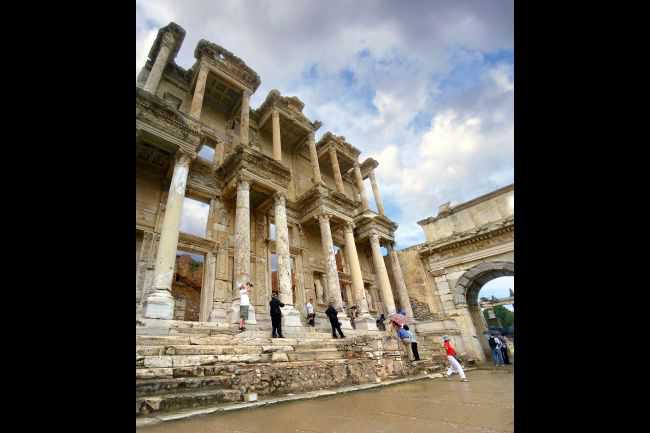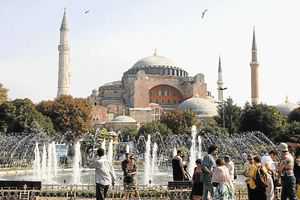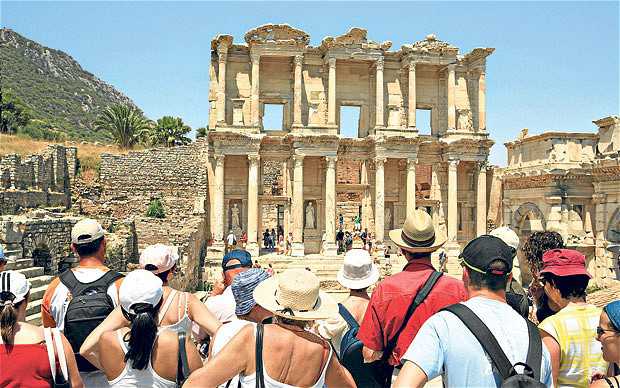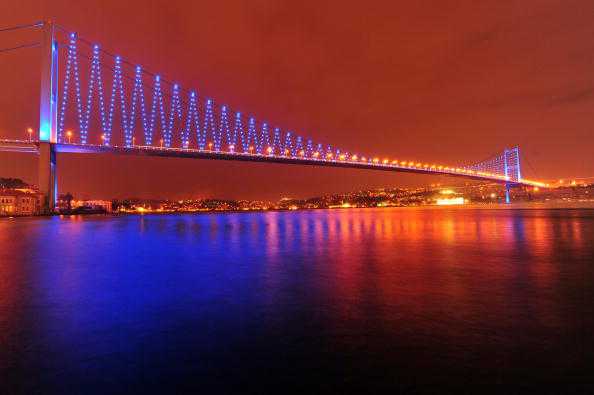Andrew Unsworth | 04 Aralık, 2011 02:06
BYZANTINE GLORY: The Hagia Sophia as seen from the Sultanahmet park, and a mosaic depicting the Dormition of the Virgin in the Chora church (below), both in Istanbul
On a visit to Turkey, Andrew Unsworth finds himself in the footsteps of the faithful, past and present
Real pilgrims travel with a mission, to go to a particular place for a specific reason. So perhaps I was not a real pilgrim, but visiting Turkey for the first time, I often felt like one. Religious or not, devotion is a feeling you cannot avoid when stepping into Hagia Sophia in Istanbul, one of the greatest buildings in the world, and one that is so familiar from travel writing and TV that you fear seeing it may be an anti-climax.
It isn’t at all, and you can tell that as you approach from the nearby 17th century Blue or Sultan Ahmed Mosque, itself a breathtaking building.
Hagia Sophia (Holy Wisdom) rises like an organic cluster of domes, minarets and buttresses from the earth, whose colours stain it. Its fabric is a jumbled record of alterations, additions and repairs, because since it was built more than 16 centuries ago, the third church on this spot, it has been restored, repaired after quakes, neglected, added to and altered innumerable times. Much of the exterior buttressing was added to prevent the massive dome, nearly 33m wide and 56m high, from collapsing.
Building was started in 532 on the orders of the emperor Justinian I, and after the first dome had collapsed in 538 it was consecrated in 562. It served as a Christian cathedral under the Eastern Orthodox and Roman Catholic churches until 1453 when Constantinople was conquered by the Ottoman Turks, then as a mosque until 1931. It has been a museum ever since.
Standing in the doorway, itself a massive door from an ancient Roman temple, I paused to take in the moment: the glimpse into the cavernous interior, darkness, columns, mosaics and bright light flooding through tier upon tier of windows. Then, standing among the throngs of tourists under that dome in a space as big as a rugby field, our guide asked us to meet outside in 30 minutes to leave for lunch. “Right,” I said, “in 45 minutes,” and fled.
This is almost a joyous building, and Justinian was probably justified when he said: “Solomon, I have outdone thee.” Everywhere dark plays with light, heavy columns and piers contrast with floating domes and apses, and above all, exquisite mosaics of Christ and angels live alongside verses from the Koran. Restorers have been sensitive to the need to keep both Christian and Muslim elements of the decoration. The harmony is striking.
You look up, but you cannot help but look down as well for the marble floor is uneven, with slabs cracked by age and earthquakes, even in the upper gallery from where, like an empress of old, you can peer down into the void of the hall.
Whether it was vanity or faith that inspired men to make such places, you cannot help saying a prayer before leaving, pausing again and again for one last look, then heading for a glass of tart pomegranate juice from the vendors outside.
. CHORA
On a hot afternoon, a colleague and I walked down a scruffy and nondescript Istanbul street in search of both a restaurant specialising in Ottoman cuisine and a church museum a friend had advised me not to miss.
They turned out to be next door to one another, but both closed for the afternoon break. So we sat under a tree in the garden of the Kariye or Chora church, looking at the marigolds and roses in the heat, and the ancient walls and buttresses that supported the church. Noises came from the playing fields in the valley below where there was a fair of sorts in progress.
Eventually inside the dark, cool interior, we were greeted by scenes both similar and very different to Hagia Sophia: entrance halls or narthex, vaults, domes, mosaics and frescoes, yes; but on a far smaller and more intimate scale, a monastery or country church more than a cathedral in the capital of the Roman and Byzantine Empire.
The main body of the church – well, museum since 1945 – has few remaining mosaics, the side chapel or parecclesion has bright frescoes, including six impressive saints in black-and-white vestments in the apse.
But the real glory of Kariye is the mosaics in the two entrance lobby areas – the inner tells the story of the Virgin Mary’s life in pictures, the outer the story of Jesus, his birth, life and miracles. In two domes, he is depicted at centre surrounded by all his ancestors.
My favourite scene was of the miracle at the wedding in Cana, with Christ looking on as servants pour water from jugs into huge terracotta urns before it is turned into wine – always, I have thought, the most practical of miracles.
Mary’s is perhaps more interesting as it depicts her birth, her parents, St Anne and Joachim, her introduction to Joseph who is always pictured with his existing son, a young adult, even on the way to Bethlehem, and the Annunciation. Finally, without getting into theological complexities, her death or dormition in Jerusalem with Christ holding an infant in swaddling clothes as a symbol of her soul.
The mosaics are both human and simple. Always in the background are buildings, pools, trees, soldiers, apostles, animals and pheasants, with acanthus leaves or flowers tucked into corners.
Inspired by the art, I was carried away and bought a panel of modern painted tiles depicting a tree at a shop over the road. I have no idea what to do with it. Later, the lead in the paint on the tiles was to cause a bit of embarrassment with an airport scanner, but that is another story.
. EPHESUS
On the west coast of Turkey near modern Selçuk, Ephesus was the third stop on my pilgrimage, the ruins of the ancient Greek and Roman city mentioned in the Bible. The apostle John lived here and could have written his gospel here; Paul also lived here and wrote his letter to the Corinthians here, and while he was imprisoned in Rome he wrote his Epistle to the Ephesians.
Ephesus had a population of 250000 at its peak, and an amphitheatre that could seat 25000. It had its famous library of Celsus, to which Anthony and Cleopatra donated books. Its temple of Arternis or Diana was one of the Seven Wonders of the Ancient World and some of its columns ended up in Hagia Sophia after it was destroyed in 401 by the Bishop of Constantinople.
The remains of the city centre cluster almost incongruously in a valley that could be in the Magaliesberg: the rest has gone. Large groups of tourists, most from cruise ships docked in nearby Kusadasi, stream along Curetes Street, which runs down the valley to the library, its ancient paving chiselled with grooves to prevent you slipping.
At the library I was keen to find the underground passage that, I had been told, led to the nearby brothel. Our conservative guide was having none of it – she had never heard of the tunnel and, no, the building she had just shown us was an ordinary house. But then her English did not even include the word brothel, even if the guide books did.
Perhaps the most enigmatic site at Ephesus is outside the town, on top of a hill covered in pine trees. It is a humble stone house now rebuilt as a chapel where, many believe, the Virgin Mary lived out her life after being brought here by St John.
It’s a perfect spot to retire even if a bit far from the shops and library, but the ruined house was only “discovered” in the late 19th century after a sick German nun had a vision of the place and priests went looking for it.
The House of the Virgin Mary is now a place of both pilgrimage and tourist tat, depending on your faith, and has been visited by four popes. This is a matter of faith: the tradition of Mary living in Ephesus only started in the 12th century.
We joined the short queue into the house, where each visitor is allowed two candles, a moment before the altar, and leaves to light the candles outside. On the terrace below, I gulped cool water from the tapped spring because I was thirsty, almost forgetting that it was miraculous water.
Do you have to wish? Is it bad to keep the candles? I tucked mine into my camera bag for a friend back home who is blessed with a lot more faith than I.
You can pray outside the house, by tying a prayer written on a scrap of paper or cloth onto a long wall covered in thousands of prayers. The avenue of souvenir sellers back to the parking lot was even longer, so it was impossible to leave without buying a small silk icon of the Virgin. For a friend, of course.
- – Unsworth visited Turkey as the guest of Turkish Airlines, which flies daily from Cape Town/Johannesburg to Istanbul





